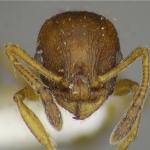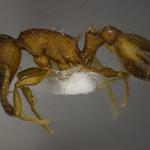Until recently the ant Temnothorax albipennis was known as Leptothorax albipennis (=tuberointerruptus) and had been misidentified as Temnothorax tuberum in Britain. It appears that all mainland records of Temnothorax tuberum refer to T. albipennis (Orledge, 1998). Workers of T. albipennis are smaller than those of Leptothorax acervorum, and generally distinguishable from workers of the three other British Temnothorax species, by their combination of darkened antennal clubs, straight and relatively short propodeal spines, and rather poorly-defined darkening on their gasters.
British mainland records come only from southern England and from Wales. Most are from sites on or near the coast, a notable exception being the record from Castle Drogo, South Devon (Alexander, 1983). There are no confirmed records from Ireland.
On continental Europe T. albipennis has been recorded from The Netherlands, southern France, northern Spain, south and central Germany and central Italy.
Listed as a Nationally Notable (Na) species (Falk 1991). Work for this Atlas has shown that the species is currently known from 40 post-1970 10 km squares on mainland Britain and so the status should be revised.
In Britain, T. albipennis colonises warm, south-facing, open rocky areas, typically coastal cliffs, screes, undercliffs, slumped cliff slopes and old quarries.
Alate males and females are produced during June and July and have left the nest by the middle of August (from data in Partridge (1993)). There are no field records of swarming, but laboratory observations suggest that mating flights occur during the two hours following sunrise (Plateaux 1984).
Nests are most frequently found between rock laminae, in rock cavities and crevices, on rock surfaces under mat-forming plants, or on soil under stones. Between rock laminae the workers often surround the nest with a 'wall' of soil particles and rock fragments. There are several records of nests within the dead stems of herbaceous and shrubby plants, in rotting wood and in old snail shells. Near Dungeness, Kent, nests have also been found amongst pebbles and gorse roots, and in peat over pebbles (Felton, 1965). Colonies rarely exceed 350 workers, and have a single queen. Adult workers are produced each year during the summer months.
Temnothorax albipennis workers forage singly. They scavenge small arthropods and may also take small live invertebrates (Orledge, 1995). No carbohydrate sources have been documented, but the author's observation of large numbers of workers on umbellifer flowers suggests that nectar is taken.
2025



